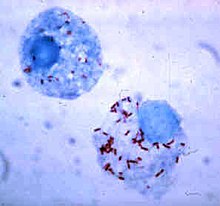Intracellular bacteria
 From Wikipedia - Reading time: 5 min
From Wikipedia - Reading time: 5 min

Intracellular bacteria are bacteria that have the capability to enter and survive within the cells of the host organism.[1] These bacteria include many different pathogens that live in the cytoplasm and nuclei of the host cell's they inhabit. Of these different pathogens that infect humans, are Mycobacterium tuberculosis and also Toxoplasma gondii. [2] Many of them are capable of growth extracellularly, but some of them can grow and reproduce only intracellularly (obligate intracellular parasites). Besides bacteria, there are other kinds of intracellular microorganisms.
Examples of non-obligate intracellular bacteria include members of the genera Brucella, Legionella, Listeria, and Mycobacterium. Examples of obligate intracellular bacteria include members of the order Rickettsiales and members of the genus Mycoplasma.[1]
See also
[edit]References
[edit]- ^ a b Levinson, Warren (2018). Review of medical microbiology and immunology (15th ed.). New York. ISBN 978-1-259-64450-4. OCLC 1225889723.
{{cite book}}: CS1 maint: location missing publisher (link) - ^ Haridas, Viraga; Ranjbar, Shahin; Vorobjev, Ivan A.; Goldfeld, Anne E.; Barteneva, Natasha S. (2017-01-01). "Imaging flow cytometry analysis of intracellular pathogens". Methods. Flow Cytometry. 112: 91–104. doi:10.1016/j.ymeth.2016.09.007. ISSN 1046-2023. PMC 5857943.
 KSF
KSF